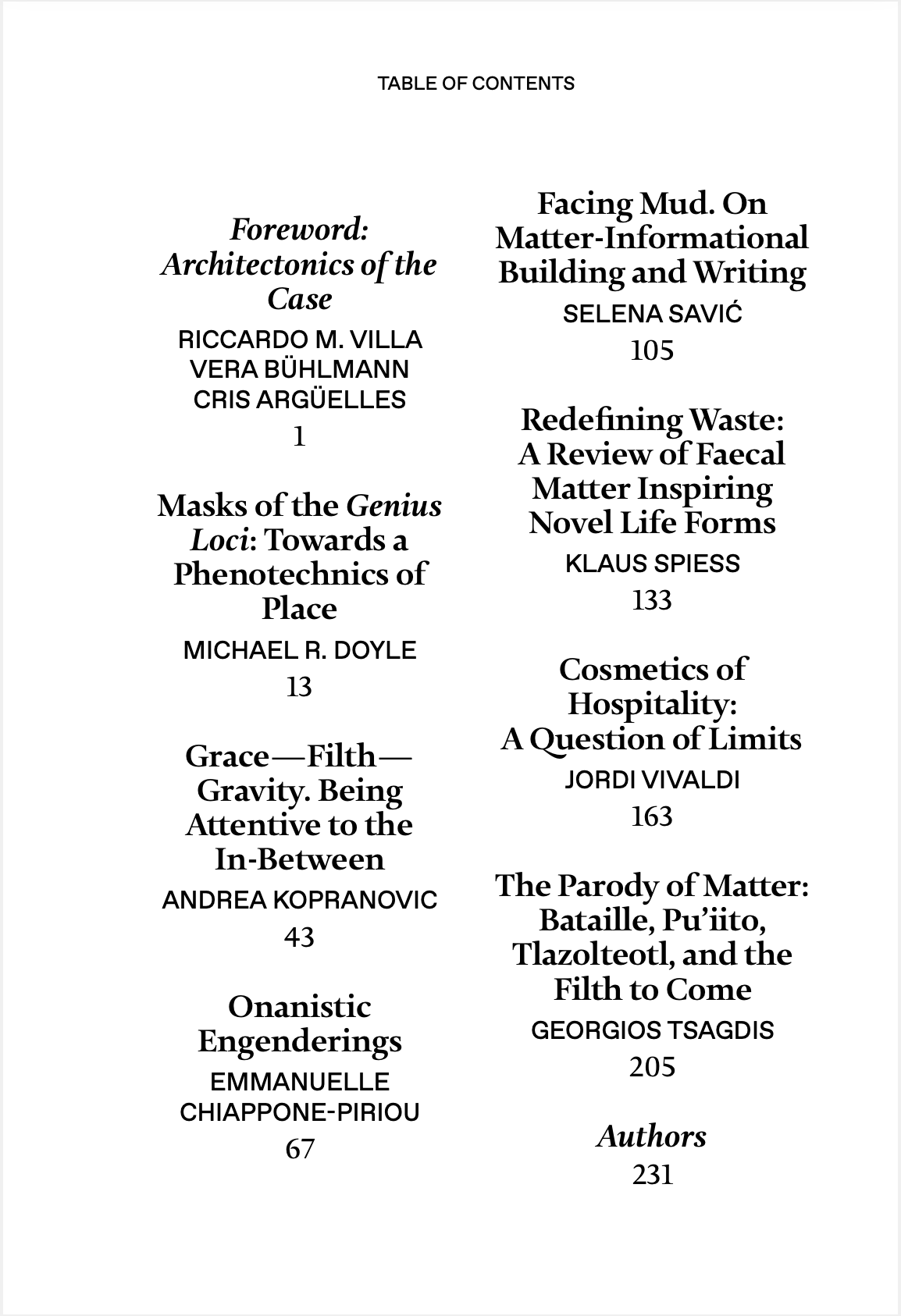Edited by Vera Bühlmann, Riccardo M. Villa, Cris Argüelles
“Inmundo”, “inmundicia”; from the Latin term “inmunditia”: without purity or order.
When conceived in light of its etymology, the Spanish translation of the term “filth” reveals a subtle yet significant association: it connects physical uncleanness, dirtiness and noisomeness to inmunditia, a deprivation from the Roman mundus, a lack of the universal systematics articulating the Greek cosmos. To be filthy would thus mean to be void of kosmetikhe (cosmetics), to be untouched by the techne providing order and decorum to the universe. It is the announcement of an exodus and exile: the abandonment of the mundus, a civilised realm governed by harmonic regularities and neat identities, in order to land in a worldless territory, a marginal province populated by all sorts of unorderable miscegenations.
By amalgamating beings and flesh conventionally indexed to different realms, today’s acknowledgement of our zoe/geo/techno natures has brought about a new situation. Chatbots, robotic rays, driverless cars or synthetic landscapes appear as filthy entities whose enigmatic mixedness makes their worldness quiver – not by distancing them from a given mundus, but by engendering multiple forms of cosmetics. In its overlapping of multiple habitational tempers, this scenario questions the notion of home: constructed of literal and metaphorical walls, the home has conventionally made sense as an architectural apparatus by erecting boundaries that, in parallel to the architecture’s distinction between interior and exterior, segregate order from chaos, civitas from barbarie, safety from peril. Culture from nature. However, in light of today’s acknowledgement of the hybridization between these pairs, I propose to think of the question of the home in terms of hospitality, raison d’être and leitmotiv of this essay. Hospitality, the Greek xenia, a form of pact, a contract, a play of hide and seek, care and generosity towards the figure of the unknown, the foreign, the xenos, but also an opportunity for inventiveness and oxygenation that extends to the community, to the generation, to a genealogy today including multiple zoe/geo/techno regimes. How to conceive the notion of hospitality with respect to such multinatural constellations? Is it possible to think of it in terms that are affirmative or inventive rather than prescriptive or compassive? What could it mean to do that? And why try? How to imagine such hospitality with respect to today’s amalgamation of modes of inhabitation involving beings of human and non-human affiliation? How to let them come, to let them arrive? How to cultivate figures of hospitality in which habits do not engulf or fortify us but leak into more active, more spectral and perhaps even more exuberant manners of living well together today?
The following pages accommodate and attend to these questions by circling around the notion of limit. If inhabitation implies the articulation of spaces within spaces, aren’t limits playing a cardinal role with respect to the question of hospitality? Isn’t their conceptual nature consisting precisely in holding flesh together-in-their-difference? I propose to interweave hospitality with the limit’s differential sameness and autoreferential difference by foliating it into three codifications: the limit-contour (Where does something end?); the limit-action (How far does the power of something go?), and the limit-milieu (What might be opened within the limit itself?). The numerous turns, overlaps, collisions, angles, jumps and intertwinings operating between these three limital codes orchestrate the cosmetics of hospitality proposed in this essay: articulations of habitational techniques (techne) seeking to collect everything that can be considered yet without exhausting it all (cosmos). To this end, I suggest to lodge ourselves into the enigmatic yet decisive Roman ceremonies of the inauguratio; in their cosmological vocation, the foundational rites of Roman cities constitute a promising camping ground and shifting land from which to experiment with new lines of flight regarding hospitality, coming into resonance with our times by articulating four figures of hospitality based on the notions of transmutation, triangularization, tuning, and matryoshka.


